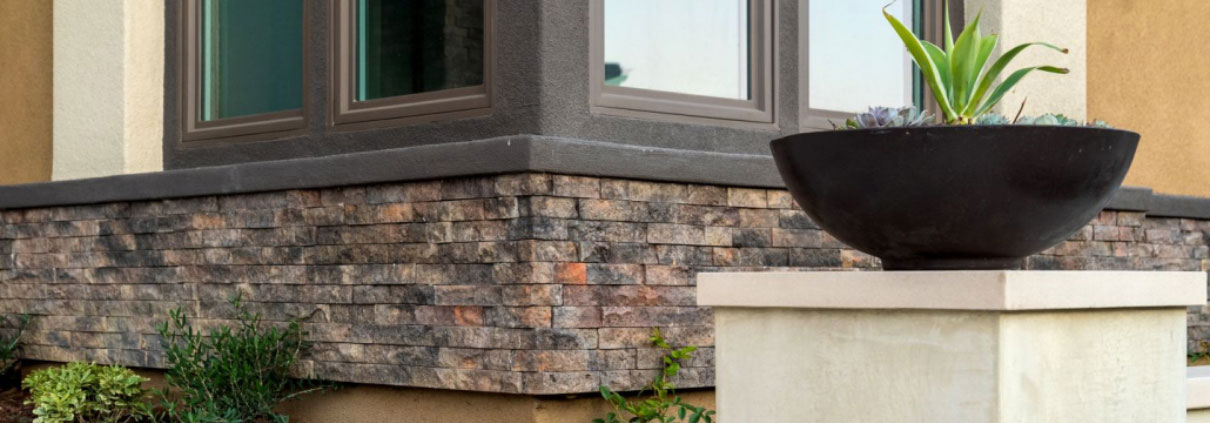
Mastering the art of building with stone wall blocks is a rewarding endeavor that marries the beauty of natural elements with structural integrity. Whether you're aiming for a traditional dry stone wall or a more modern design with stone veneers, understanding the nuances of working with stone can transform your outdoor space into a masterpiece of hardscape designHardscape design refers to the planning and creation of non-living elements in a landscape, such as ....
In this guide, we'll explore tips and tricks for building with stone wall blocks, offering guidance for both DIY enthusiasts and those looking to collaborate with professional hardscape contractors.
Stone wall blocks, whether natural stone, stone veneers, or concreteConcrete is a composite material made from a mixture of cement, sand, gravel, and water. It is one o... alternatives shaped to mimic the irregularity and texture of real stone, offer a robust and aesthetically pleasing option for constructing walls. From the rustic charm of dry stone walls to the polished look of structural stone walls reinforced with mortarMortar is a mixture of cement, sand, and water, used as a bonding agent in masonry construction. It ..., the choice of stone can significantly impact the visual appeal and functionality of the wall.
Building with stone wall blocks requires a blend of artistry and precision. Beyond the foundational techniques of dry stone walling and using mortar, several additional methods can significantly enhance the durability and aesthetic appeal of your stone wall projects. Here’s a deeper dive into advanced building techniques that can elevate your craftsmanship.
Incorporating geometric designs into stone walls adds a layer of visual interest and modern flair. This involves carefully selecting and arranging stones to create patterns or motifs within the wall. The challenge lies in balancing the natural irregularity of individual stones with the desire for a cohesive geometric pattern.
Planning is crucial; sketching the design beforehand and selecting stones that fit the envisioned pattern can lead to stunning results that fuse natural beauty with human creativity.
Creating contrast through texture can dramatically impact the wall’s visual appeal. This technique involves using stones with varying surface textures in different sections of the wall or alternating between smooth stone veneers and rough, natural stones.
The juxtaposition of textures not only highlights the individuality of each stone but also adds depth and character to the overall structure. Paying attention to how sunlight and shadow play on the textures can guide the placement of stones for maximum effect.
Stone walls need not be monochromatic. Exploiting the natural color variation and irregular shape of exterior stones can transform a simple wall into a vibrant feature of your landscape. This technique requires sorting stones by color before construction and strategically placing them to create gradients or color blocks. Whether aiming for subtle shifts or bold contrasts, color variation can convey mood and complement the surrounding landscape.
Proper drainage is critical for maintaining the structural integrity of stone walls, particularly in retaining wall applications. This involves more than just the placement of stones; it requires integrating drainage solutions into the wall’s design.
Constructing a weephole system or including a perforated pipe behind the wall ensures water does not accumulate behind the wall, preventing pressure buildup that could lead to structural failure.
For enhanced stability, especially in dry stone walling, mastering the double-wall technique is invaluable. This involves building two thinner walls parallel to each other and filling the space between them with smaller stones or rubble. The key is to ensure that the outer walls interlock and that the infill is packed tightly to prevent settling. The double-wall technique not only strengthens the wall but also improves its insulation properties.
The boxed-in method is an effective technique for constructing straight walls and involves creating a temporary wooden frame (or "box") that guides the placement of stones, ensuring uniformity and alignment.
After laying a foundation, the frame is used to contain the stones as they are stacked, filled, and leveled. Once a section is complete, the frame is removed and repositioned to continue the construction. This method is particularly useful when working with irregular-shaped stones, as it helps maintain a straight and even facade.
When working on restoration projects or building walls that complement traditional architectural styles, using lime mortars can be critical. Unlike modern cement-based mortars, lime mortars offer breathability and flexibility, which are essential for the longevity of stone walls in older buildings. Learning to mix and apply lime mortar correctly is a skill that can add authenticity and value to restoration projects.
While building with stone wall blocks can be a fulfilling DIY project, partnering with a professional hardscape contractor can ensure the success of more complex or large-scale projects. West Hills Masonry offers expertise in all aspects of stone wall construction, from design consultation to the selection of materials and expert installation.
Ready to transform your outdoor space with the timeless beauty and durability of stone wall blocks? Our team of skilled hardscape contractors is dedicated to bringing your vision to life, combining artisan craftsmanship with the highest quality materials. Contact West Hills Masonry today and bring your hardscape project to life!
 Carlos Gonzales
Carlos GonzalesLocations We Serve
Schedule A Consultation